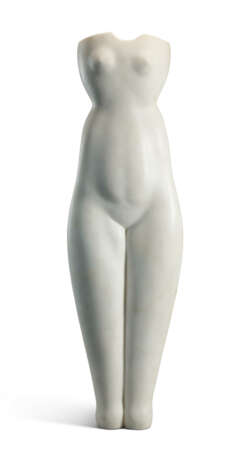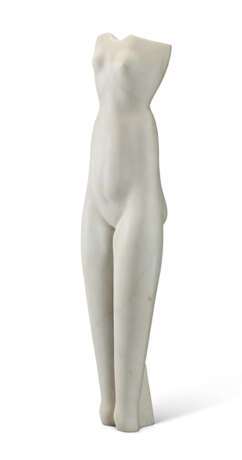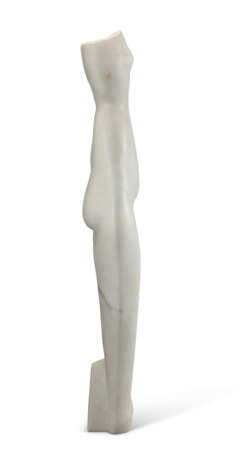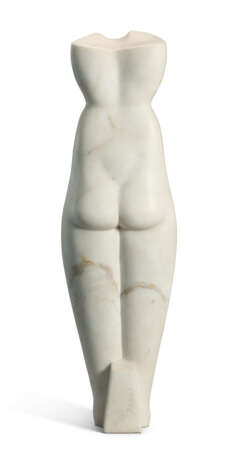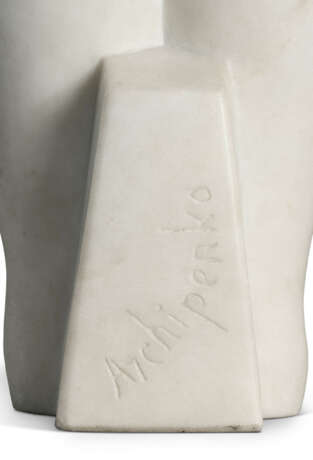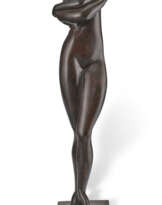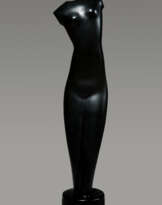ID 1400122
Lot 212 | Alexander Archipenko (1887-1964)
Estimate value
€ 700 000 – 1 000 000
Symmetrical Torso
signé 'Archipenko' (au dos)
marble blanc
Hauteur: 68.8 cm.
Conçu en 1921; cette version en marbre exécutée en Allemagne avant 1923
signed 'Archipenko' (on the back)
white marble
Height: 27 1/8 in.
Conceived in 1921; this marble version carved in Germany by 1923
Provenance
Rudolf et Bertha Frank, Allemagne (acquis auprès de l'artiste à l'exposition de Darmstadt en 1923).
Collection particulière, Europe (par descendance); vente, Christie's, New York, 5 novembre 2014, lot 11.
Acquis au cours de cette vente par le propriétaire actuel.
Literature
H. Hildebrandt, Alexandre Archipenko, Son œuvre, Berlin, 1923, pl. 21 (une autre épreuve illustrée; titré 'Torso').
W. Beeh, Sammlung Rudolf und Bertha Frank, Darmstadt, 1986, p. 60 (illustré en couleurs, p. 61; titré 'Flacher Torso').
A. Barth, Alexander Archipenkos plastisches Œuvre, Francfort-sur-le-Main, 1997, p. 268, no. 137 (illustrée, p. 269).
M. Ackermann et K. Müller, éds., Kunstmuseum Stuttgart, Stuttgart, 2005, no. 80 (illustré).
Catalogue raisonné en ligne de l'œuvre d'Alexander Archipenko, no. s.21-01-4327 (illustré en couleurs).
Exhibited
Darmstadt, Mathildenhöhe Kunsthalle, Deutsche Kunst 1923, mai-octobre 1923, p. 53, no. 404 (illustré; titré 'Torso').
New York, Kingore Gallery, The Archipenko Exhibition, 1924, no. 26.
(probablement) Philadelphia, Palace of Fine Arts, Paintings, Sculpture and Prints in the Department of Fine Arts, Sesqui-centennial International Exposition, 1926, p. 87, no. 1421.
(probablement) New York, The Anderson Galleries, Archipenko, Cattalogue of exhibition and description of Archipentura, 1928, p. 16, no. 50.
(probablement) New York, Nierendorf Gallery, Alexander Archipenko, Sculpture, Paintings, Drawings, 50th One Man Show in U.S.A., Works from 1909-1944, janvier-février 1944, no. 12.
(probablement) Lyon, Musée des Beaux-Arts; Rennes, Musée des Beaux-Arts et Nantes, Musée des Beaux-Arts, AlexandrE Archipenko, 1969, no. 39.
(prêt long terme) Darmstadt, Hessisches Landesmuseum, 1980-1992.
(prêt long terme) Stuttgart, Galerie der Stadt Stuttgart, 1992-2005.
(prêt long terme) Stuttgart, Kunstmuseum Stuttgart, 2005-2014.
Further details
La frontalité claire, dépouillée et hiératique de Symmetrical Torso, semblable à une déesse, témoigne de l'engagement d'Alexander Archipenko dans le nouveau classicisme de l'après-Première Guerre mondiale, une tendance qu'il avait anticipée dans des sculptures telles que les célèbres Flat Torso, en 1914 et White Torso, en 1916. Renonçant aux contours anguleux, aux ouvertures découpées et aux contrastes élaborés entre convexité et concavité des éléments formels de ses figures cubistes et de ses sculptures-peintures de la décennie précédente, Archipenko privilégie une expression plus simplifiée et réductionniste de la forme plastique.
« En utilisant des formes corporelles abstraites, parfois très stylisées, Archipenko a renoncé à la représentation, ce qui a libéré de nouvelles énergies expressives », écrit Christa Lichtenstern. « Archipenko a découvert une formule pour représenter élégamment le corps humain, qui pouvait être réconciliée avec les vagues attentes que beaucoup avaient d'une forme humaine lisse, post-cubiste » (Canto d'Amore, cat. exp., Kunstmuseum, Bâle, 1996, p. 152 et 153).
Reconnu comme l'un des sculpteurs les plus influents de l'avant-garde parisienne d'avant-guerre, Archipenko a découvert que le marché de l'art allemand était manifestement plus réceptif à son travail. La première exposition individuelle de l'artiste dans un musée a eu lieu au Folkwang, à Hagen, en 1912. L'année suivante, Herwarth Walden présente ses œuvres au public berlinois dans sa galerie Der Sturm ; il organise une grande exposition en 1921 qui voyage de Berlin à Wiesbaden, Hanovre et Munich. Une rétrospective est présentée à Potsdam la même année, coïncidant avec la publication de l'album Archipenko de Theodor Däubler, la première monographie consacrée à l'œuvre du sculpteur. Au cours de cette année faste, Archipenko épouse Angelica Schmitz, une éminente sculptrice allemande qui expose sous le nom de Gela Forster. Archipenko ferme son école d'art à Paris (tout en y conservant un atelier) et s'installe à Berlin, où les étudiants s'inscrivent avec empressement à ses cours.
Tout en s'inspirant de ses modèles maniéristes préférés de la Renaissance, et même de figurines cycladiques de la première antiquité, Archipenko a insufflé une sensibilité germanique et gothique à son traitement de la figure. « L'élongation et la distorsion gothiques émanent d'idées religieuses, de l'extase et de la gravitation vers une puissance divine très élevée », écrit-il. « Les styles égyptien, gothique et moderne, en s'appuyant sur des qualités abstraites créatives, prouvent qu'ils sont subordonnés au même dynamisme de la nature avec son pouvoir de transformation perpétuel qu'ils cherchent à exprimer » (Archipenko, Fifty Creative Years, New York, 1960, p. 40).
La détérioration de l'économie allemande d'après-guerre et la violence politique dans les rues de Berlin ont conduit Archipenko à émigrer aux États-Unis à l'automne 1924, où il espérait capitaliser sur ses débuts en solo, trois ans plus tôt, à la Société Anonyme de Katherine Dreier et Marcel Duchamp, à New York. La seule autre version en marbre connue de la présente sculpture se trouve aujourd'hui au Eskenazi Museum of Art de l'Université de l'Indiana à Bloomington.
La présente version, quant à elle, fut acquise auprès de l'artiste à l'exposition de Darmstadt en 1923 par le couple Rudolf et Bertha Frank. Originaires de Mannheim, ils ont commencés à collectionner des œuvres du modernisme classique après la Première Guerre mondiale. Leur collection fait aujourd’hui l’objet d’un prêt au Kunstmuseum de Stuttgart et comprend 42 peintures, sculptures et œuvres sur papier, dont d'importantes œuvres expressionnistes d'Erich Heckel, Emil Nolde, Karl Schmidt-Rottluff, Wilhelm Lehmbruck, Alexej von Jawlensky et Otto Dix.
The clear, unadorned, hieratic frontality of the goddess-like Symmetrical Torso demonstrates Alexander Archipenko’s engagement with the new classicism of the post-First World War period, a tendency which he had anticipated in sculptures such as the well-known Flat Torso, 1914, and White Torso, 1916. Dispensing with the angular contours, cut-out openings, and elaborate, convex-concave contrasts of formal elements in his cubist figures and sculpto-paintings of the previous decade, Archipenko favored instead a more simplified, reductionist expression of plastic form.
“By using abstracted—sometimes highly stylized—body forms, Archipenko achieved a renunciation of representation which in turn released new expressive energies,” Christa Lichtenstern has written. “Archipenko discovered a formula for elegantly representing the human body, which could be reconciled with the vague expectations many people had of a smooth, post-Cubist human form” (Canto d’Amore, exh. cat., Kunstmuseum, Basel, 1996, p. 152 and 153).
Lauded as a leading and singularly influential sculptor in the pre-war Paris avant-garde, Archipenko discovered the German art market to be demonstratively more receptive to his work. The artist’s first solo museum exhibition took place at the Folkwang, Hagen in 1912. The following year, Herwarth Walden introduced his work to the Berlin public at his gallery Der Sturm; he organized a major show in 1921 that travelled from Berlin to Wiesbaden, Hannover, and Munich. A retrospective ran in Potsdam the same year, coinciding with the publication of Theodor Däubler’s Archipenko Album, the first monograph written on the sculptor’s work. During this auspicious year Archipenko married Angelica Schmitz, a leading German sculptress who exhibited under the name Gela Forster. Archipenko closed his art school in Paris (while retaining a studio there) and moved to Berlin, where students eagerly enrolled in his classes.
While drawing on favorite Renaissance mannerist models, and even Cycladic figurines from early antiquity, Archipenko imparted a Germanic, Gothic sensibility to his treatment of the figure. “The Gothic elongation and distortion emanate from religious ideas, ecstasy, and gravitation toward highly soaring divine power,” he wrote. “The Egyptian, Gothic, and modern styles, by leaning toward creative abstract qualities, prove that they are subordinated to the same dynamism of nature with its perpetual transforming power which they set out to express” (Archipenko: Fifty Creative Years, New York, 1960, p. 40).
The worsening state of the post-war German economy and political violence in the streets of Berlin led Archipenko in the fall of 1924 to emigrate to America, where he hoped to capitalize on his solo debut, three years earlier, at Katherine Dreier and Marcel Duchamp’s Société Anonyme, New York. The only other known marble version of the present sculpture was shown at the 1926 Sesquicentennial International Exhibition in Philadelphia, and today is in the Eskenazi Museum of Art, Indiana University, Bloomington.
The present version was acquired directly from the artist at the Darmstadt exhibition in 1923 by the couple Rudolf and Bertha Frank. Originally from Mannheim, they began collecting works of classical modernism after the First World War. Their collection is now on loan to the Kunstmuseum Stuttgart and comprises 42 paintings, sculptures and works on paper, including important Expressionist works by Erich Heckel, Emil Nolde, Karl Schmidt-Rottluff, Wilhelm Lehmbruck, Alexej von Jawlensky and Otto Dix.
| Artist: | Alexander Porfiryovich Archipenko (1887 - 1964) |
|---|---|
| Art style: | Modern art |
| Auction house category: | Sculptures, Statues & Figures |
| Artist: | Alexander Porfiryovich Archipenko (1887 - 1964) |
|---|---|
| Art style: | Modern art |
| Auction house category: | Sculptures, Statues & Figures |
| Address of auction |
CHRISTIE'S 9 Avenue Matignon 75008 Paris France | ||||||||||||||
|---|---|---|---|---|---|---|---|---|---|---|---|---|---|---|---|
| Preview |
| ||||||||||||||
| Phone | +33 (0)1 40 76 85 85 | ||||||||||||||
| Fax | +33 (0)1 40 76 85 86 | ||||||||||||||
| Conditions of purchase | Conditions of purchase | ||||||||||||||
| Shipping |
Postal service Courier service pickup by yourself | ||||||||||||||
| Payment methods |
Wire Transfer | ||||||||||||||
| Business hours | Business hours
|
